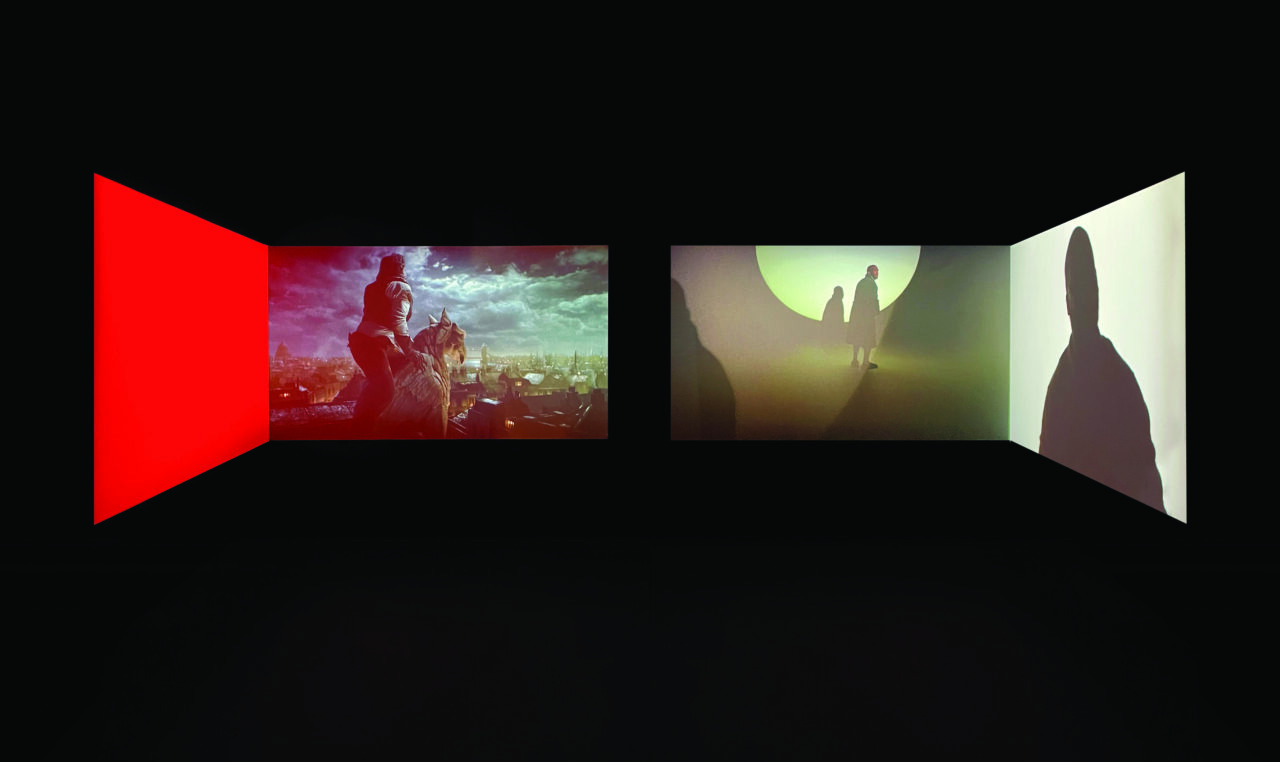In Death of A, Kandis Williams adapts Death of a Salesman, by the American playwright Arthur Miller, delving into its theatrical use of soliloquy and the complexities of exposing a character’s interiority. The result is a monologue performed by a Black actor in an abstract space that acquires context through images projected onto adjacent screens. Having the protagonist, Willy Loman, played by a Black man complicates the universalising potency of Miller’s character, underpinned by the great human themes of dreams, moral conflicts, fate, failure and death. But as Saidiya Hartman explains, the transubstantiation of the circumscribed life of a Black body into a universalisable abstraction of the human is improbable, if not impossible. The relationship of this Willy Loman with the category of the human is marked by a dissonance that Williams accentuates by layering images over the actor’s voice. His dreams and his death are imbued with the visual memory of Black bodies being attacked, fetishised and spectacularised on the internet, on television, in Hollywood or on Broadway.
From the beginning we see images of nuclear detonations. These tests began in the 1940s and started to be filmed and televised very soon after, coinciding with the years of the writing, premiere and reception of Death of a Salesman. To these synthesised and aestheticised clips of explosions that seem to abstract their violence, Williams adds others that document the destructive effects of bombs on a house, sometimes inhabited by test dummies representing a typical American family. Miller’s indications for the play’s set describe a house with transparent walls that are traversed by the past and the future, a house with an air of a dream, as if its interior were an exteriorisation of Loman’s mind. Miller initially wanted his play to be titled The Inside of His Head and to be set inside a giant skull. The salesman enters the scene saying that he is exhausted, that he couldn’t make it any further on the road, as he couldn’t concentrate on his driving because images of his surroundings and his own daydreams assaulted him. The exploding bombs and razed homes are coupled with quotes by J. Robert Oppenheimer on the denial of evil within us and by Martin Luther King Jr. on the relation between his own dream and the American dream, adding contexts that diffract Miller’s script. The humanist boundary that Miller establishes concerning the porosity of the human psyche towards its social environment is broken down and opened up to a much deeper and more remote trauma: here the brutal destruction of the bomb gets inside the house and reaches its inhabitant. Miller’s Marxist conception of the American dream is directly confronted with the enormity of the evil that sustains it, exposing the denial of slavery as the foundational violence that structures racial capitalism.
Through this exercise in audiovisual collage, Williams intensifies Miller’s experimental aspirations regarding the staged construction of a psychological portrait and the temporality of theatrical narration. Death of a Salesman’s cumulative development without transitions is concentrated into a continuous soliloquy saturated with images that undo its internal congruence even further. Images of Black American families from the archive, of Black singers on TV, of Black boxers and basketball players in front of an audience, of couples consisting of a Black actor and a white actress, of African art objects in documentaries, inside glass urns in museums, of gold being stolen recorded by security cameras, of vampires, zombies and other monsters from movies… As Loman expresses his weariness and his anxieties about being liked, accepted, competitive, successful, the images derail his thoughts and his voice. They turn his body into a signifier and a political symbol for the spectator, activating a collective unconscious created by the American cultural industry, of which Death of a Salesman has been a part since it premiered.
Kandis Williams (Baltimore, 1985) lives and works in Los Angeles, New York and Berlin. Her practice spans collage, sculpture, video, performance, writing, publishing, and curating. She explores and deconstructs critical theory, addressing issues of race, nationalism, authority and eroticism. Williams is also the founder and editor of Cassandra Press, a publishing and educational project focusing on spreading ideas, distributing new languages, propagating dialogue around ethics, aesthetics, femme driven activism and Black scholarship. She has recently exhibited at the Whitney Biennial, 52 Walker, and the Museum of Modern Art (New York), the Institute for Contemporary Art at Virginia Commonwealth University (Richmond), Haus der Kulturen der Welt and the Julia Stoschek Collection (Berlin), as well as in the Hammer Museum (Los Angeles) and The Studio Museum in Harlem (New York). Her work is included in numerous public collections, such as those of the MoMA, Hammer Museum, MOCA, and the Baltimore Museum of Art.







